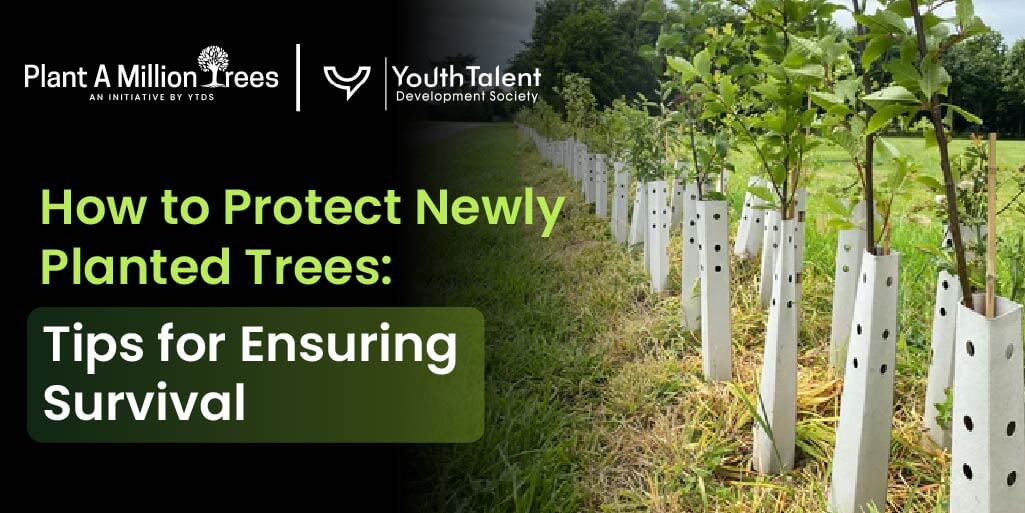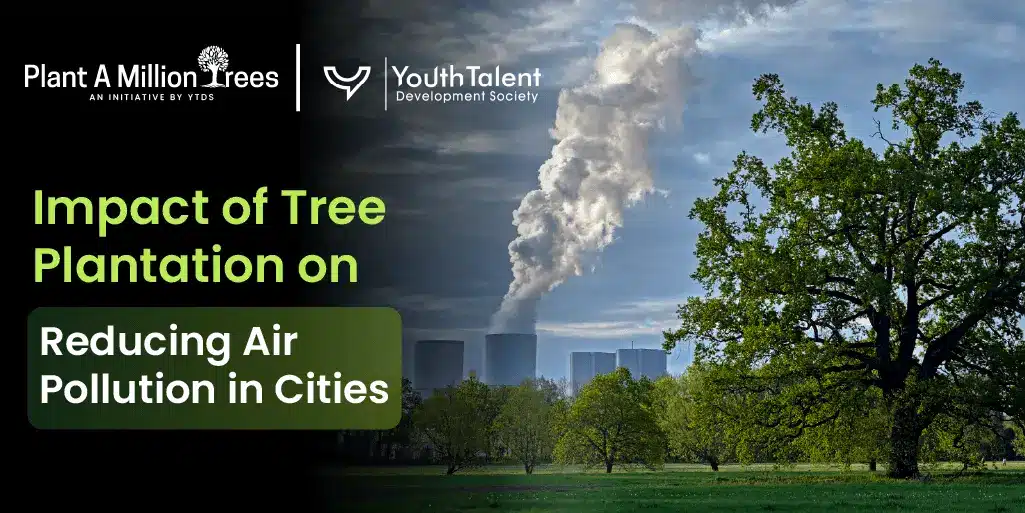Where the land meets the sea, mangroves stand as silent protectors. Mangrove trees with thickly entangled roots and salt-tolerant...
Urban greening and reforestation projects are becoming increasingly popular, but planting is the initial step; the most important is making sure their survival is guaranteed.
The initial five years require care especially, as this determines whether a tree can mature into a towering canopy or one which goes unnoticed. The Youth Talent Development Society (YTDS) knows of this essential need and supports the idea of nurturing nature from the roots up.
This guide champions sustainable tree care, including techniques to look after and protect trees newly planted, nurturing their growth.
Working on soil health, water management, controlling pests, and involving the community will guarantee urban trees make it through and thrive, imparting lifelong ecological and aesthetic value to the city.
Why Tree Aftercare is Crucial for Growth
Newly planted trees are extremely vulnerable, especially in urban and semi-urban environments. Factors like pollution, erratic weather, poor soil conditions, and human or animal interference can quickly compromise their survival.
This is why it’s critical to protect newly planted trees, especially during their first few years of growth — a phase where the foundation for long-term health is laid.
At this early stage, saplings require extra care because they:
- Have underdeveloped root systems that struggle to absorb water and nutrients
- Are easily damaged by physical impact or harsh weather
- Are highly sensitive to drought and overwatering
- Face competition from weeds and invasive grasses for resources
Without proper aftercare, even the best planting efforts can fail. Protecting saplings during this phase ensures they grow strong enough to thrive for decades to come.
5 Common Mistakes That Lead to Tree Death
Even with good intentions, many young trees die because of avoidable mistakes. These errors are surprisingly common in plantation drives and community efforts.
Here are five of the most common ones:
1. Overwatering or Underwatering
Too much or too little water can damage roots. Young trees need consistently moist—but not soggy—soil to thrive.
2. Improper Staking
Tying a tree too tightly or staking when not needed can restrict natural movement and weaken the trunk.
3. Incorrect Mulching
Piling mulch directly against the trunk traps moisture and causes rot. Always leave a gap of a few inches around the bark.
4. Neglecting Post-Plantation Care
Planting is just the start. Without regular watering, mulching, and protection, saplings are unlikely to survive the first year.
5. Exposure to Harsh Conditions
Lack of guards or shade protection exposes trees to animal damage, sunburn, or frost, all of which can kill a young tree.
By avoiding these common mistakes, tree survival rates can be significantly improved — turning good intentions into lasting green impact.
8 Must-Do Practices to Safeguard New Trees

To give every sapling the best chance to grow into a strong, healthy tree, follow these 7 essential practices. These tips come from years of on-ground experience with plantation drives and community forestry.
1. Site Selection: Laying the Foundation Right
Before even planting, the choice of location affects future health. Select a site that has good drainage, appropriate sunlight exposure, and sufficient space for growth.
For cities practicing urban reforestation, evaluating traffic, pollution levels, and underground utilities is essential.
2. Tree Staking: Support Without Restriction
Before even planting, the choice of location plays a critical role in the future health and growth of a tree. It’s important to select a site with good drainage, appropriate sunlight exposure, and ample space for the tree to grow and spread its roots.
In urban areas practicing reforestation, additional factors must be considered, such as traffic patterns, pollution levels, and the presence of underground utilities like pipes and cables.
These elements can significantly impact the tree’s ability to thrive, as excessive pollution, limited root space, or physical barriers can hinder its growth and overall health.
A thoughtful, well-planned location ensures the tree has the best possible foundation for long-term success.
3. Mulching for Trees: More Than Just Aesthetic
Mulching recovers a lot of tree help, especially just one post-planting. In fact, these benefits very support the growth and health of trees.
Mulch retains the water in the soil, which is so essential for the young tree, particularly in dry or irregular weather conditions. The growth of weeds is suppressed by mulch; therefore, weed competitors share fewer nutrients and less space with trees.
Another good thing about mulch is that it keeps the soil temperature under check by cooling the roots during hot summer days and warming them through winter, consequently encouraging steady growth.
Mulch also prevents mechanical injuries caused by mower and trimmer from damaging tree bark and roots. Organic mulches like wood chips or bark are best.
Spread it in a 2- to 4-inch layer around the tree base. It shouldn’t touch the tree when laid down because moisture may pool up and rot the bark.
4. Watering Schedule for New Trees: Consistency Over Quantity
Either overwatering or underwatering newly planted trees is harmful, so a coordinated watering schedule is essential in building roots. Water the tree each day for weeks 1–2 to ensure soil is perpetually moist.
For weeks 3–12, water at intervals of 2–3 days to facilitate the roots getting used to the change. Beyond 12 weeks, weekly watering until the roots are fully developed, typically 1–2 years.
Deep watering is vital to make the roots dig deeper, which will stabilize the tree. Slow trickle watering allows water to penetrate through the ground gradually, and runoff on the surface will not occur because the roots will be capable of growing solid in the soil.
5. Tree Protection Tips from Physical Damage
Urban settings expose new trees to different hazards such as animals nibbling on bark, lawn mower strikes, and pedestrian compaction, all of which can be extremely detrimental to their health and development.
Tree guarding or fencing around young trees is one way of safeguarding trees against such hazards, an effective way of keeping them from physical damage.
These barrier guards hinder grazing on the trunk by animals and protect the tree from accidental damage due to lawn mowing or foot traffic.
Additionally, informing residents about the need for tree care and involving residents in plantation drives for trees can reduce human-caused injury rates.
By giving the communities a feeling of responsibility towards the trees, it is possible for them to become actively involved in ensuring that greenery in cities establishes and flourishes successfully.
6. Preventing Sapling Death: Early Warning Signs
Sapling death is often caused by neglect, and catching the early signs of neglect will be essential to prevent sapling death. There are some general signs that your tree(s) are struggling.
One thing to look for is leaves yellowing or browning. This can be a sign the tree is not getting enough nutrients or is stressed from too little or too much water; two extremes that a sapling can neither survive.
Others leaves wilting, even after you have watered, can point to root problems from either poor drainage in the soil or damage to roots from something digging in the area.
Fungal growth on the trunk at soil level can indicate root rot or disease on the saplings roots. Slow growth can indicate that you tree is unable to establish a healthy root system or is stressed from nutrient or environmental problems.
Regular inspection of your trees is key – and especially after storms or periods of high and/or low temperature – storms can create physical damage to trees, while high or low temperatures can create and exacerbate existing problems that the tree has.
Early interventions through proper management of trees, to schedule watering more often, beginning treatment for a pest or disease, or improving poor growing conditions in the soil can go a long way to saving the tree and ensuring a healthy future for the sapling.
7. Pruning Young Trees: Less is More
During the first year after planting, there should be very little pruning. The only branches you should consider taking off the tree in the first place are dead, damaged, or diseased.
You want to allow the tree to establish itself, which will help reduce the stress from too many cuts. Pruning too much initially will shock the plant, which will slow down the establishment.
When your tree is more established, during the second or third year, structural pruning can be implemented at this time.
At this point, you will be allowing the tree to grow in a shape that has a strong structural framework. This type of pruning tells the tree how to grow, you remove any crossing or competing branches that can interfere with the healthy growth of the tree along with air circulation.
If you add a little bit of pruning at a time, you help the tree develop healthy structure and avoid the risk of large-scale damage.
8. Fertilizing: Caution Over Convenience
Newly planted trees don’t require fertilizers right away. A new tree’s most pressing need is to anchor itself in its new surroundings with a healthy root system.
Adding fertilizers at an early stage will cause the tree to expend energy on establishing its foliage rather than rooting and may severely weaken the tree’s new roots.
During the first growing season, a new tree will be focusing all its energy on just growing without the worry of food (fertilizers) (Mulch and water are important as well).
The first leaves will appear after the tree has focused its energy on settling in on its surrounding and establishing roots, not on foliage growth. A
fter the first growing season, if there are signs of nutrient deficiency, slow-release organic fertilizers can apply without pushing the young tree.
Introduction slow-release fertilizers as a supplement to the soil in small doses won’t overwhelm the young tree, and it could provide some balance to growth Sustainable, balanced young tree growth now will ensure tree sustainability and health for years to come.
Community Engagement: The YTDS Approach
Youth Talent Development Society (YTDS) has launched a number of campaigns about tree care following planting. By way of educational campaigns, and hands-on workshop activities, YTDS guides communities to take responsibility for green spaces.
Planting trees in urban areas is a civic responsibility rather than solely the responsibility of environmentalists.
Leveraging Urban Forestry India Models
Cities like Pune, Bengaluru, and Delhi have emerged as leading examples of successful urban forestry models in India, demonstrating how strategic planning and community involvement can transform cityscapes.
These cities have effectively integrated public-private partnerships, municipal initiatives, and NGO-led efforts to not only increase green cover but also ensure high tree survival rates.
Organizations like the Youth Talent Development Society (YTDS) have played a key role in this success by combining grassroots awareness, scientific planting methods, and long-term tree care.
Their models show that when citizens, governments, and organizations work together, urban forestry can thrive. Residents in other localities can draw inspiration from these approaches—adopting similar frameworks, collaborating with local bodies, and actively participating in plantation and maintenance drives—to create greener, more sustainable neighborhoods.
FAQs: Caring for Newly Planted Trees
Q1: How often does a newly planted tree need watering?
A: The first couple of weeks water every day for tree establishment & settling. Week 3-12, water every 2-3 days. After 12 weeks, water once a week until it is established railway (root network) usually within 1-2 years. Water deeply.
Q2: Do I stake every new tree I plant?
A: Not necessary. Stake if a tree cannot remain upright on its own, or if you have a situation that results in severe winds. Sometimes improper or unnecessary stakes do more damage than good.
Q3: What is the best mulch?
A: Organic mulch. Wood chips, bark types, straw are great mulch materials. Mulch around the tree base 2-4 inches deep but stay a few inches from the base to avoid rot or insect problems.
Q4: What are the reasons mulching is so essential for newly established trees?
A: Supplementing the soil moisture to reduce evaporative and transpiration losses, encouraging weed suppression, helps moderate, stabilize soil temperature, and protects a new root system from excessive weather extremes; there is also the potential for saving a sapling’s roots, that get damaged due to inadvertent lawn-care practices.
Q5: Should I use tree guards or fences around my newly planted tree to protect it from animals or mowers?
A: Tree guards or small fence barriers around your newly planted tree/s are a good option; barriers are a good option to prevent bark damage of the sapling due to animals and also accidental damage from mowers and/or trimmers.
Q6: How long should I wait before fertilizing my new tree?
A: Fertilizer should not be applied immediately after planting a tree. It is best to wait at least one full growing season, however, if you have done a soil test first and if your sapling does require fertilization a specific slow-release organic fertilizer would be okay to add based on what is best for your sapling.
Conclusion
Planting a tree is a symbol of hope and commitment, but the difference between planting a tree and having it grow strong and healthy is considerable.
As Indian cities begin to green and become more sustainable, the responsibility of nurturing plants and trees that have just been planted becomes a much larger responsibility.
Planting and growing trees isn’t just about planting trees and plants. it is about regular watering, mulch, staking with care, and maintenance.
These basic steps can help enable everyone to have a hand in an effort to create and manage resilient green spaces, and resilience means the ability to withstand the day to day impacts of urbanization.
By partnering with YTDS and completing plantation events in various locations and regions, remember we are not just planting saplings, we are participating in planting the future. Grow a sapling today; help it grow into a legacy for the future. Let’s ROOT for a greener India!




